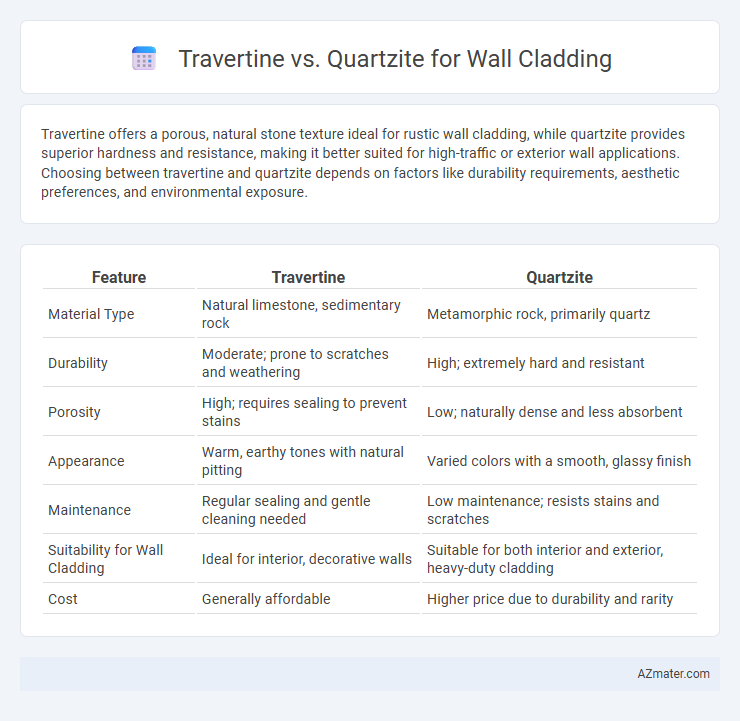Travertine offers a porous, natural stone texture ideal for rustic wall cladding, while quartzite provides superior hardness and resistance, making it better suited for high-traffic or exterior wall applications. Choosing between travertine and quartzite depends on factors like durability requirements, aesthetic preferences, and environmental exposure.
Table of Comparison
| Feature | Travertine | Quartzite |
|---|---|---|
| Material Type | Natural limestone, sedimentary rock | Metamorphic rock, primarily quartz |
| Durability | Moderate; prone to scratches and weathering | High; extremely hard and resistant |
| Porosity | High; requires sealing to prevent stains | Low; naturally dense and less absorbent |
| Appearance | Warm, earthy tones with natural pitting | Varied colors with a smooth, glassy finish |
| Maintenance | Regular sealing and gentle cleaning needed | Low maintenance; resists stains and scratches |
| Suitability for Wall Cladding | Ideal for interior, decorative walls | Suitable for both interior and exterior, heavy-duty cladding |
| Cost | Generally affordable | Higher price due to durability and rarity |
Understanding Travertine and Quartzite
Travertine is a natural sedimentary stone characterized by its porous texture and warm earth tones, commonly used in wall cladding for its classic, rustic appearance and ease of installation. Quartzite, a metamorphic rock formed from sandstone, offers superior hardness and resistance to weathering, making it ideal for durable, high-traffic wall cladding applications with a sleek, crystalline finish. Both materials provide distinct aesthetic and structural benefits, with travertine favoring decorative appeal and quartzite excelling in strength and longevity.
Key Differences Between Travertine and Quartzite
Travertine, a porous sedimentary rock with a textured surface, contrasts with quartzite's dense, non-porous metamorphic composition, offering enhanced durability and resistance to scratches for wall cladding. Travertine often features natural pits and a matte finish, while quartzite provides a smoother, polished appearance and greater hardness, making it suitable for high-traffic or exterior applications. Maintenance-wise, quartzite requires less sealing compared to travertine due to its lower porosity, impacting long-term performance and upkeep.
Aesthetic Appeal: Which Looks Better?
Travertine offers a warm, natural look with distinctive porous textures and earthy tones that evoke a rustic, Mediterranean aesthetic, perfect for creating an inviting and timeless wall cladding. Quartzite presents a sleek, modern appearance with a glassy, crystalline surface and a wide range of colors, ideal for contemporary designs seeking durability and elegance. The choice between travertine and quartzite for wall cladding ultimately depends on the desired ambiance, with travertine emphasizing warmth and texture while quartzite highlights sophistication and visual depth.
Durability and Strength Comparison
Travertine, a porous sedimentary rock, offers moderate durability with a natural, textured appearance but is more susceptible to wear and staining compared to quartzite, which is a dense, metamorphic rock known for exceptional strength and resistance to abrasion. Quartzite's hardness, often ranging between 7 and 8 on the Mohs scale, makes it highly durable for wall cladding in both interior and exterior applications, outperforming travertine, which typically rates around 3 to 4. For long-term wall cladding projects demanding robustness and minimal maintenance, quartzite provides superior strength and longevity over travertine.
Maintenance Requirements for Each Material
Travertine requires regular sealing and gentle cleaning methods to prevent staining and etching due to its porous nature, making maintenance more frequent compared to quartzite. Quartzite is highly durable and resistant to scratches, heat, and chemicals, demanding minimal maintenance with occasional cleaning and resealing to preserve its appearance. Choosing quartzite over travertine for wall cladding reduces long-term upkeep efforts and enhances durability against environmental wear.
Cost Analysis: Travertine vs Quartzite
Travertine offers a more affordable option for wall cladding, with installation costs typically ranging from $15 to $30 per square foot, compared to quartzite, which can cost between $40 and $70 per square foot due to its durability and hardness. Quartzite's higher price reflects its superior resistance to scratching and staining, making it a long-term investment for high-traffic areas. Maintenance costs for travertine may be higher over time because of its porous nature requiring regular sealing, whereas quartzite demands minimal upkeep.
Installation Process and Considerations
Travertine and quartzite differ significantly in wall cladding installation due to their material properties; travertine's porous texture requires sealing to prevent moisture absorption, while quartzite's hardness demands specialized cutting tools to avoid chipping. Proper substrate preparation is critical for both stones, ensuring a level surface and use of high-quality, polymer-modified thin-set mortar for enhanced adhesion and longevity. Weight considerations and anchoring methods vary, with quartzite's higher density necessitating stronger support systems to secure panels safely.
Best Applications for Wall Cladding
Travertine offers a natural, porous texture that enhances interior wall cladding with a warm, rustic appearance, making it ideal for accent walls and bathroom installations where moisture absorption is moderate. Quartzite provides superior hardness and resistance to weathering, making it the preferred choice for exterior wall cladding and high-traffic areas requiring durability and low maintenance. Both materials offer unique aesthetic appeal, but quartzite's strength supports heavy-use applications better than the softer, more absorbent travertine.
Environmental Impact and Sustainability
Travertine, a natural limestone formed through mineral deposits, has a lower environmental impact due to its abundant availability and minimal processing requirements, making it a more sustainable choice for wall cladding. Quartzite, although extremely durable and resistant to weathering, demands higher energy consumption during extraction and fabrication, contributing to a larger carbon footprint. Selecting travertine can support eco-friendly construction practices by reducing energy consumption and promoting the use of renewable natural materials in sustainable building projects.
Pros and Cons Summary
Travertine offers a natural, rustic aesthetic with excellent breathability and moderate durability, making it ideal for interior wall cladding but prone to staining and erosion if untreated. Quartzite provides superior hardness and resistance to scratches and weather, ensuring long-term durability and low maintenance suitable for both indoor and outdoor cladding, though it tends to be more expensive and heavier. Choosing between travertine and quartzite depends on the desired visual appeal, environmental exposure, and budget constraints for the wall cladding project.

Infographic: Travertine vs Quartzite for Wall Cladding
 azmater.com
azmater.com